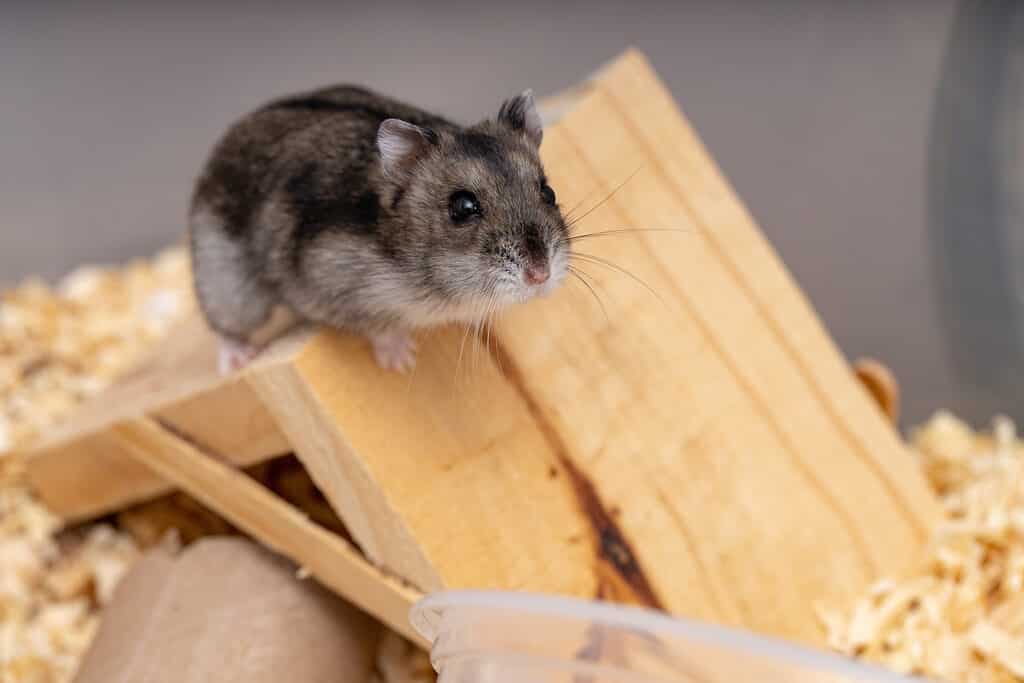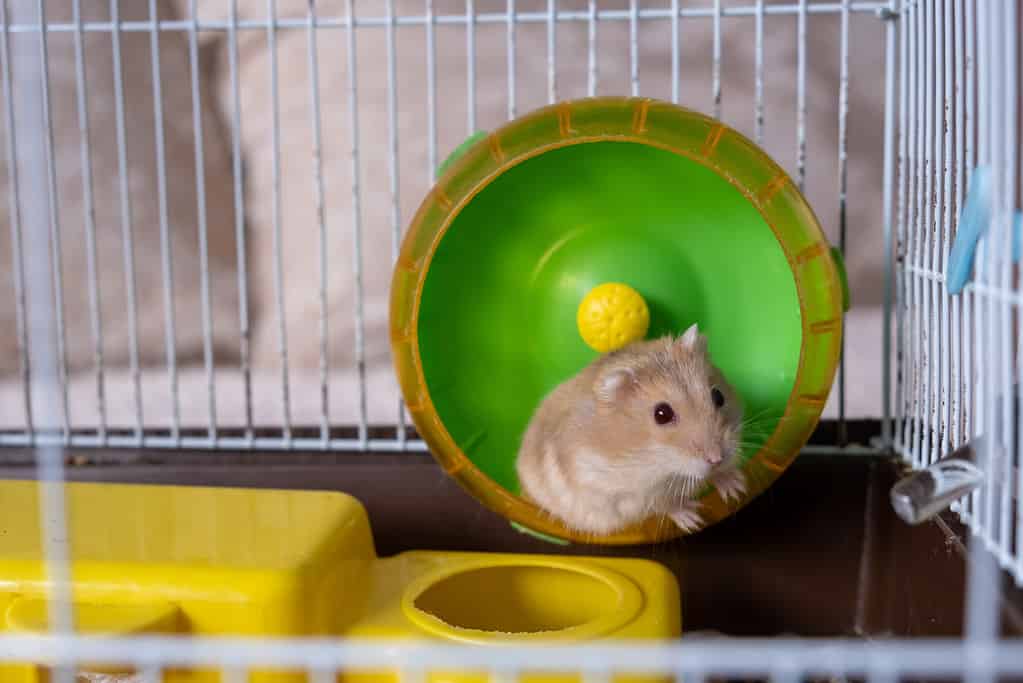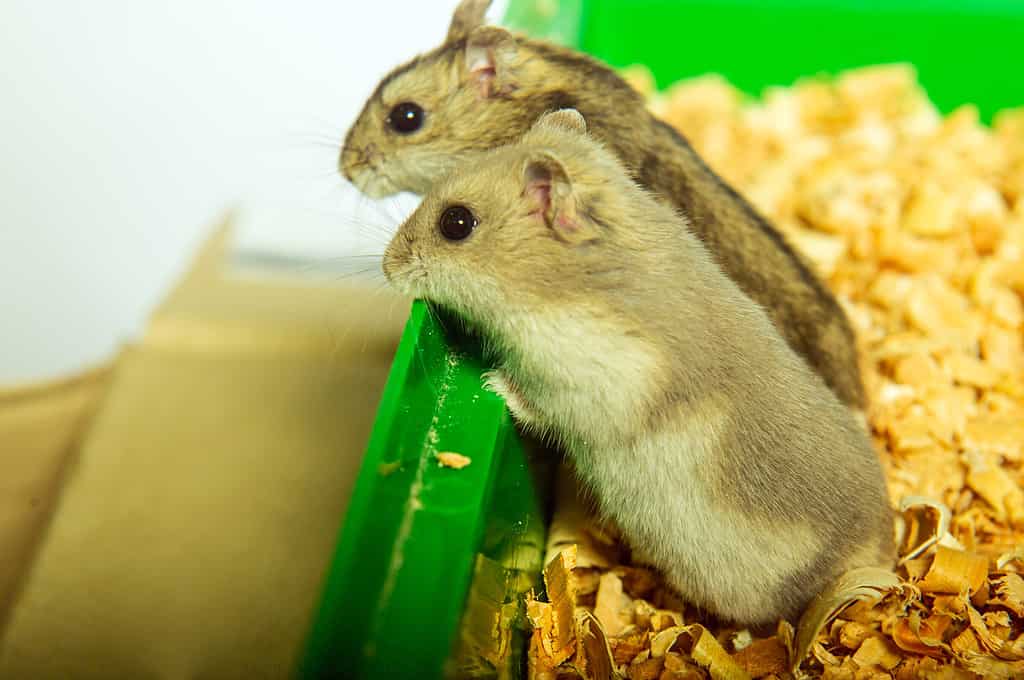If you are looking to get a pet dwarf hamster or already own one, you might be surprised to know that they are unlikely purebred. Dwarf hamsters in pet stores rarely have entirely pure genetics, despite what name they are sold under. This means that if you have purchased a winter white or Campbell’s dwarf hamster, you have probably ended up with a hybrid dwarf hamster instead.
So, what is a hybrid dwarf hamster and how do you care for one? This article tells you everything you need to know.
What Is a Hybrid Dwarf Hamster?

It is rare to find purebred Campbell or winter white dwarf hamsters nowadays.
©Elena van den Akker/ via Getty Images
Hybrid dwarf hamsters are the offspring of two different dwarf hamster species – the winter white and Campbell’s dwarves. Taxonomically, these hamsters belong to the genus Phodopus. The winter white hamster has the scientific name P. sungorus and the Campbell hamster P. campbelli.
Winter white dwarf hamsters are generally smaller and have a rounder face than the Campbell dwarf hamster. Both species are found in various coats and eye colors.
They are the most common dwarf hamsters sold in pet stores and from many backyard breeders. It is rare to find purebred dwarf hamsters available in pet stores. Your best bet at finding pedigree dwarf hamsters is from a reputable breeder who has the necessary papers to prove the history of your hamster’s genetic lineage.
Winter white and Campbell dwarf hamsters are the only known domesticated hamster species that can interbreed and successfully create hybridized offspring.
The reason these two species can interbreed is because they both have 28 chromosomes (2n=28) which don’t conflict. It is unclear whether hybrid dwarf hamsters are found in the wild, even though both of the parent species are.
History of Hybrid Dwarf Hamsters
The history of hybrid dwarf hamsters’ dates back to the domestication of winter white and Campbell dwarf hamsters. The winter whites became domesticated in the 1960s when a captured pair successfully bred in captivity. Campbell dwarf hamsters were domesticated in the early 1900s after being discovered and collected by W.C. Campbell.
As these dwarf hamsters gained popularity as pets, they were likely bred together at some point. This interbreeding could have been done unintentionally by inexperienced hamster breeders who could not tell the difference between the species.
Otherwise, the interbreeding was done deliberately so certain breeders could create a hybrid species with new color morphs. This would allow them to sell their hybrid hamsters for a higher price than their purebred parents. Hamster breeders at the time probably did not know any better.
Breeding pure winter white and Campbell hamsters together was so prolific around the world that the hybrids eventually became more common than the purebreds themselves.
Generations of Hybrid Dwarf Hamster

Hybrid dwarf hamsters are hamsters with another species in their bloodlines and are no longer pure.
©GlobalP/ via Getty Images
Hybrid dwarf hamsters are categorized into different generations, as with most hybrid animals or mixed breeds. The first generations (F1) were created by an entirely pure winter white and Campbell dwarf hamster reproducing. However, this did not come without complications for both the female winter white hamster and their offspring.
Whereas F2 generational hybrid dwarf hamsters will have two F1 parents and so forth. The generation of your hybrid dwarf hamster can affect their physical traits, which so why some hybrids resemble one parent more than the other. Many pet store hamsters are the result of generations of hybrid hamsters breeding with purebred parents far removed from their lineage.
Should You Breed Different Species of Dwarf Hamsters Together?
No, you should avoid breeding two different species of dwarf hamsters together. Reputable dwarf hamster breeders will not breed with hybrid hamsters or interbreed the species.
Keep in mind that winter white hamsters are slightly smaller than Campbell dwarf hamsters. If a male Campbell dwarf hamster impregnated the female winter white, birth complications were a serious concern. Female winter whites did not have the correct body anatomy to support the larger Campbell dwarf offspring.
It is believed that many female winter white hamsters died giving birth to the hybrid offspring or suffered serious injuries. This is still a risk today if you were to deliberately breed a pure male Cambell and female winter white dwarf hamster together.
Thanks to researchers and hamster experts, we now know that interbreeding dwarf hamsters to create hybrids is not recommended. The potential complications and congenital issues in the litter are not worth it. Furthermore, hybrids could breed out their purebred parents from captivity.
Overview Of Hybrid Dwarf Hamsters
This section will cover the appearance, lifespan, and health issues of hybrid dwarf hamsters.
General Appearance

Hybrid dwarf hamsters have characteristics of both Campbell and winter white hamsters.
©Vinicius R. Souza/Shutterstock.com
A hybrid dwarf hamster’s appearance can vary significantly in both size and coloration. Some hybrid dwarf hamsters will look more like a Campbell or winter white depending on their genes. However, just because they resemble one species more, doesn’t mean that they are a purebred of that specific species.
For example, a hybrid hamster could have more physical traits than either a Campbell or winter white dwarf hamster. This can create confusion amongst dwarf hamster owners as they assume that their hamster is not a hybrid. To further add confusion, hybrid hamsters with a higher percentage of genes from their winter white parents can change color in response to the seasons. It still does not make them a purebred winter white dwarf hamster though.
Generally, hybrid dwarf hamsters are around 2 to 3 inches in size and weigh up to 3 oz. They closely resemble their parents and do not necessarily have one distinctive feature that makes them identifiable as hybrids.
Most hamster owners look for the traits of both a purebred winter white and Campbell hamster mixed into one hamster to identify a hybrid. This could mean that the hybrid dwarf hamster has the body of a Campbell, but the ear placement and rounded face of the winter white.
Colors and Markings
Hybrid dwarf hamsters are available in numerous color morphs similar to the purebred species. A common hybrid dwarf hamster color is standard grey with a white underbelly known as sapphire.
Other hybrid dwarf hamster colors and markings include:
- Black
- Opal
- Pearl
- Agouti
- Platinum
- Black color
- Mottled
- Cream
- Argente
They can also have either ruby or black eyes.
Lifespan
The lifespan of a hybrid dwarf hamster is not much different than the purebred species. Most hybrid dwarf hamsters live for about two to three years with proper care and access to veterinary treatment. However, some hybrid hamsters may only live for about a year with poor genetics resulting from bad breeding practices.
Health Issues
Breeding two different hamster species together with different morphological traits is a gamble with genetics. You do not know what type of health or temperamental issues the litter of hybrid offspring can have. This also applies when breeding two hybrid hamsters together, as their no proper breeding standard that you would breed for. This is why hybrid hamsters sometimes have aggression (biting) or neurological issues.
Hybrid hamsters with neurological issues will obsessively repeat certain behaviors, such as spinning or backflipping. Hamsters with neurological issues that impact their everyday functions often need to be euthanized by a veterinarian. These issues are unpleasant for hamsters and make it difficult for them to eat and sleep as normal.
Caring for a Hybrid Dwarf Hamster
A hybrid dwarf hamster’s care requirements are not any different than the winter white or Cambell dwarf hamster.
Let’s look at what their care entails below.
Cage

This is a great example of a suitably sized hamster cage (over 700 square inches).
©Jennifer Carlsson, CC BY-SA 4.0, via Wikimedia Commons – Original / License
Despite their small size, a spacious cage is essential for hybrid dwarf hamsters. According to veterinarian experts at PetMD, the minimum recommended cage size is about 40 × 17.5 × 24 inches. This would equate to around 700 square inches of unbroken floor space, so cage levels do not count.
Therefore, the majority of pet store hamster cages are way too small and should be avoided. Fortunately, there are various suitably sized hamster cages available from online retailers, small businesses, or repurposed storage bins and fish tanks.
Exercise Wheel

Hamsters enjoy running on an exercise wheel. Unfortunately, the one is the picture is way too small.
©iStock.com/ANATOLii SAVITSKii
Hybrid dwarf hamsters are active during the evenings, night, and early mornings. They can often be seen running around their cage creating tunnels and storing food. Even if your hybrid dwarf hamster had a large cage, they still require an exercise wheel to release pent-up energy.
The wheel should have a diameter of at least 8 to 10 inches and have a smooth surface. Avoid any wheels with a mesh or barred surface as they can injure your hybrid dwarf hamster.
Substrate/Bedding
All hamsters require a deep layer of substrate in their cage, with a minimum depth of 6 inches for dwarf hamsters. Hybrid hamsters are burrowing animals, so digging is instinctive.
There are various types of substrate marketing for hamsters, but not all of them are safe. You want to avoid using substrates like sawdust, pine, cedar, or any scented substrates. Rather choose unscented paper-based, aspen shavings, or hemp beddings instead.
Hybrid dwarf hamsters can also benefit from having a sand bath in their enclosure. They use sand to naturally clean themselves as hamsters should never be bathed in water. Only unscented and sterilized sands are safe for hybrid dwarf hamsters.
Diet
Hybrid dwarf hamsters are omnivores like the winter white and Campbell. Their main diet should include a commercial pelleted food formulated for hamsters. Seeds, dried insects, and fresh fruit and veggies can be offered as a treat. Many hamster experts recommend mixing two or more different hamster foods to create a varied diet and to achieve a balanced guaranteed analysis.
Cohabiting

Hamsters prefer a solitary lifestyle and should not be housed together.
©Rus_S/ via Getty Images
Hybrid dwarf hamsters should never be kept together in the same cage. This is true regardless of if they are siblings or the same sex. Hybrid hamsters should live alone and do not crave the companionship of their species.
Keeping hybrid hamsters together is not only stressful for them, but can result in injuries, resource competition, and even death from fighting. You should not keep hybrid hamsters with any domesticated hamster species, even other dwarves.
In Summary
Hybrid dwarf hamsters are the result of two domesticated dwarf hamster species interbreeding. They usually have a mixture of both the winter white and Campbell dwarf hamster traits, but some hybrids resemble one parent more than the other.
Caring for a hybrid dwarf hamster is similar to other dwarf species, with a spacious cage, healthy diet, and deep substrate being essential.
Hybrid hamsters are widespread in many parts of the world, and the main types of dwarf hamsters from pet stores and inexperienced breeders.
Thank you for reading! Have some feedback for us? Contact the AZ Animals editorial team.








